1. Patients with hand dermatitis, even if suspected endogenous, always be liberal when considering patch testing. The hands are exposed to a multitude of substances both willingly and unknowingly. Hand dermatitis is often also costly both for society and the individual.
2. Patients with dermatitis that has a clear history that connects aggravation/elicitation to a particular exposure.
3. Patients with a dermatitis that does not heal after adequate treatment.
4. When a patient comes with no former history of dermatitis, an exogenous dermatitis should be ruled out .
5. When the diagnostic framework does not fit with the dermatosis investigated, the possibility of contact allergy should be considered [1].
The diagnosis of allergic contact dermatitis is actually divided in three steps, patch testing, deciding on exposure for the found allergen, and finally deciding on whether the dermatitis under investigation can be explained by the found contact allergy, i.e., deciding on relevance. In this chapter, focus will be on with what to patch test and on how to patch test. It must be emphasized that even if the patch test procedure and patch test reading is performed according to given rules and standards, we will be limited by the fact that we only have information with regard to what we have patch tested with. The first crucial step is then with what to patch test and what to avoid patch testing with.
3.2 What Substances Have the Capacity to Be Contact Allergens?
There are several prerequisites necessary for a substance to become an allergen (Table 3.2).
Table 3.2
Prerequisites for a substance to be a contact allergen
Penetration through stratum corneum is determined by: |
The size of <1000 Da, usually <500 Da |
Sufficient number of molecules, i.e., the dose/cm2, has to be adequate both for sensitization and elicitation, that dose is however not the same. |
Metals have to be in ionic form; for other molecules, these have to be more or less lipophilic. |
In the epidermis, several factors are of importance: |
The small molecules must conjugate with proteins to enable sensitization or elicitation. |
The tertiary structure: there must be sufficient amount of antigenic determinants. |
Enantiospecificity: the three-dimensional structure is important; sometimes only one of two isomers will be sensitizers. |
Certain allergens act as allergen only after activation, they need to be chemically changed before exposure to the skin and on or in the skin in order to act as haptens, and these are called pre- and prohaptens. They can be activated, for example, by oxidation, light, or metabolization. |
Many contact allergens are weak allergens that require repeated exposure before they actually cause sensitization, but there are also strong allergens that may sensitize after one exposure. Therefore, with what to patch test is decided both by the possibility for the substance to act as a hapten and by the possible exposure in the individual that is to be tested.
3.3 Pros and Cons with a Baseline Series
In most countries, a baseline series exists based on the most frequent allergens found in the exposed population. When transferring a baseline series to a new population differences in exposure patterns might mean that the results will be misleading, i.e., if we do not patch test with the right substances, we will not get accurate results. In many countries therefore, the baseline series is a tool that changes over time. A general rule is that if an allergen is found in frequencies above 1 % in a population, this is considered a ratio that merits the allergen to be in the baseline series. A weak allergen but with a large exposure such as nickel will thus merit to be included, but also stronger allergens with a smaller exposure will be included due to their tendency to sensitize even if the exposure is less. Sometimes, other factors decide if the allergen should be in the baseline series such as the fact that legal aspects or regulatory measurements have been taken and there is a need to follow a trend as is the case with methyldibromo glutaronitrile that was actually banned in 2008 from cosmetic products on the European market.
The baseline series thus include common allergens that the tested population can meet in daily life activities (see also Chap. 6). It is important to patch test a limited number of substances. Mixes are often used within the baseline series and are necessary in order to shorten the number of allergens to patch test with i.e., the number of chambers put on the back but may be a pitfall in itself. Fragrances are such an example, where the patients to patch test with ie the number of chambers put on the back can be positive to a mix and negative to a separate substance and vice versa [2, 3]. When evaluating the patch test results, one has always to consider relevance and if necessary patch test with the separate ingredients of the mix and the patients’ own products. Within the baseline series, the test doses and vehicles should be carefully evaluated, but as our patch test technique improves and the use of substances changes also, how the allergens of the baseline series are tested must be subjected to change [4, 5]. A baseline series is of course a great advantage due to the fact that it is well standardized with regard to allergen and dose and that it, since it includes common allergens, will result in many positive reactions. It must, however, be emphasized that the series in itself may be a pitfall. You will only have results from what you have patch tested with, i.e., one has always to judge the individual patient and decide if there is a need to patch test also with other series/substances [6].
3.4 When Not to Patch Test
Even if we have an individual with a dermatitis where we suspect exposure to something in the environment to be the possible cause, there are certain situations where patch testing is contraindicated or at least must be carefully evaluated [6]. The list below is made considering that the clinician patch tests not only the well-defined allergens that are commercially available but also the patients’ own material.
Totally unknown substances/products should of course not be put on the skin! Always think of how the patient is exposed to the presumed allergen! Always require data safety sheets and ingredient lists before patch testing new products. Take into careful consideration how the product is actually thought to be in contact with the skin.
The substance is a well-known strong sensitizer and we cannot test in a well-defined dose. We might actively sensitize the patient.
We have no knowledge/not full knowledge of the product the patient is exposed to and suspect it to be a strong sensitizer. Get information on the ingredients of the product and try to patch test these separately.
When a patient product is tested, pH should always be investigated. The indicator should be slightly moistened with water before use. If the product/substance has a pH that may cause a toxic reaction in the patient and we cannot buffer the solution enough, patch testing has to be avoided. See Chap. 4 for more information.
When the patient has when presenting a generalized dermatitis also of the back, this increases the risk for a generalized flare that will make patch test reading difficult. Treat the dermatitis so that the back is healed before patch testing can be performed.
Corticosteroids or immunosuppressive therapy. Local corticosteroids have been shown to give rise to false-negative patch test results, as well as irradiation (UVB/UVA) which has been shown to modulate reactivity also in shielded areas. Oral corticosteroids have been shown to suppress reactivity. Patients on different immunosuppressive drugs have been patch tested, and positive reactions have been elicited, but the studies are scarce, and further studies are needed. If a patient is patch tested and found negative when on immunosuppressive therapy and a contact allergy is suspected to be the cause, the patient should be retested when not on the therapy [7].
3.5 Overview of Procedures of Patch Testing
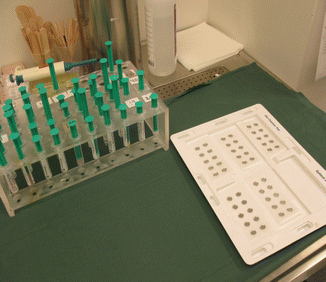
Fig. 3.1
Prepared for patch testing
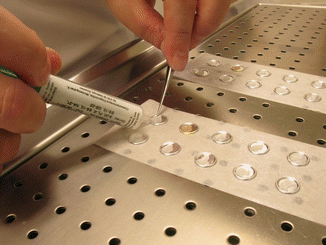
Fig. 3.2
Preparing the test chambers with the test substance just prior to use
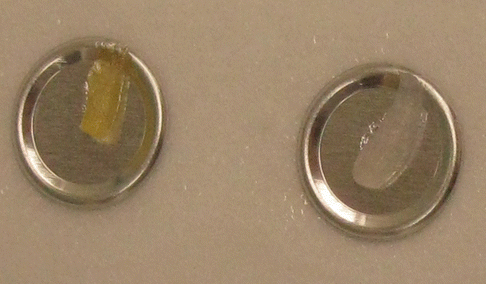
Fig. 3.3
The correct dose is of the utmost importance
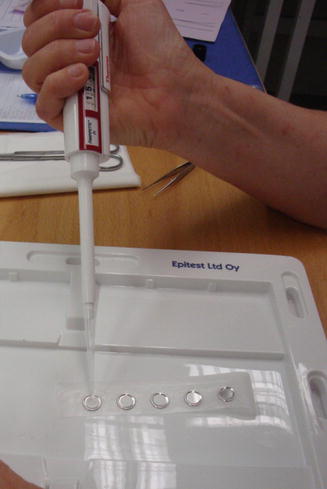
Fig. 3.4
Liquid preparations administered by micropipette for best accuracy and precision
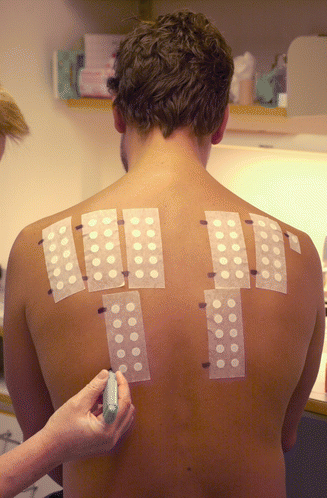
Fig. 3.5
The patch test preparations are fixed to the skin on the upper back and marked with a good water resistant marker pen
3.6 Important Technical Issues to Be Aware of
It is of importance that the patch testing procedure (Figs. 3.1–3.5) and patch test reading are standardized. In the following section, we will be referring to the allergens of the baseline series, but the same general principles adhere to all testing.
3.6.1 Stability of Test Material/How to Store
Patch test material should be stored according to recommendations from the manufacturer. Patch test substances can either be defined as chemically defined substances such as nickel and formaldehyde, compound chemicals such as colophony and para-tertiary butylphenol formaldehyde resin, or mixes. They are as such to be considered defined, but it has happened that they have proved to be unintentionally incorrectly declared or to both contain impurities and/or be degraded/chemically changed so that what is patch tested with is actually not what is declared on the labeling [8–10].
In general, patch test preparations when not used should be stored dark and in refrigerator or freezer when stored for longer periods of time. Once the substance is to be used, it should be applied on the test chamber if possible just before use Fig. 3.2. This is true especially for volatile substances [10, 11].
3.6.2 Types of Chamber
Stay updated, free articles. Join our Telegram channel

Full access? Get Clinical Tree







